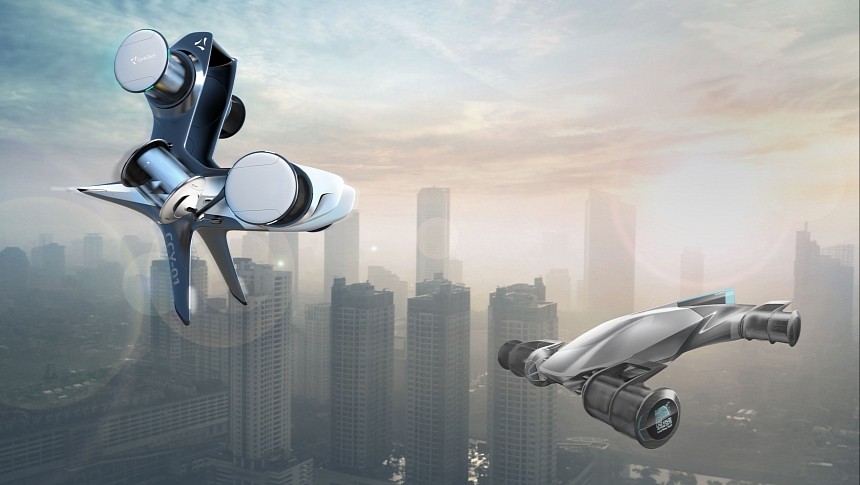It's no secret that the AAM (Advanced Air Mobility) wave is sweeping over the entire world, with hundreds of proven eVTOL (electric vertical take-off and landing) concepts ready to demonstrate their abilities. In Austria, one of the most intriguing technologies is named CycloRotor.
While other AAM companies are focusing on certification requirements and flight tests, the Austrian CycloTech broke an industry record with the most extensive noise test campaign in the aeronautical industry, carried out outdoors, for this specific technology. It happened at the Wels General Aviation Airport in Austria, where the CycloRotor propulsion system proved to be almost as quiet as a simple conversation between two people.
The unprecedented test campaign revealed that the CycloRotor's sound pressure level at a 100-meter (328 feet) distance is no more than 59 dBA, making this system exceptionally quiet.
The CycloRotor claims to be a game-changing propulsion technology for the eVTOL market. It's described as a 360-degree thrust vector control system. This basically means that the thrust's magnitude and direction are controlled directly and instantly within a full circle in all directions – up, down, forward, and backward. In contrast, other propulsion systems provide a push or pull movement in a single direction.
Why is the CylcoRotor better? Well, it aims to smooth the transition phase from hover to forward flight, which is the most challenging aspect for eVTOLs. It also improves maneuverability and control. This leads to agile aircraft that are better equipped to handle even the harshest weather conditions and operate efficiently in crowded airspace.
The 360-degree thrust vector system is also flexible. It can work as an aircraft's main propulsion system or as an auxiliary solution in a hybrid configuration with other systems.
CycloTech is still refining this propulsion concept, including the aeroacoustic signature, which will be eventually integrated into electric vehicles of the future, including air taxis and cargo drones. Although revolutionary, this technology is based on an older concept known as the Voith-Schneider-Propeller, originally developed for the maritime industry.
CycloTech kicked off indoor flight tests back in 2021, using an 83-kg (183 lb) demonstrator fitted with four CycloRotors. So far, the Austrian company says it has completed more than 100 flights with this particular prototype.
This recent noise test campaign came after CycloTech got the green light from Austro Control (the national aviation safety authority) to perform outdoor flight tests in specific conditions (a controlled test area of 2,500 square meters/27,000 square feet in VLOS, meaning that the aircraft must remain in the operator's line of sight at all times).
The Austrian tech company hopes to integrate this unconventional technology into so-called Aircars used mainly for commuting and autonomous, high-precision drones for a variety of tasks, from delivery to offshore installations inspection.
The unprecedented test campaign revealed that the CycloRotor's sound pressure level at a 100-meter (328 feet) distance is no more than 59 dBA, making this system exceptionally quiet.
The CycloRotor claims to be a game-changing propulsion technology for the eVTOL market. It's described as a 360-degree thrust vector control system. This basically means that the thrust's magnitude and direction are controlled directly and instantly within a full circle in all directions – up, down, forward, and backward. In contrast, other propulsion systems provide a push or pull movement in a single direction.
Why is the CylcoRotor better? Well, it aims to smooth the transition phase from hover to forward flight, which is the most challenging aspect for eVTOLs. It also improves maneuverability and control. This leads to agile aircraft that are better equipped to handle even the harshest weather conditions and operate efficiently in crowded airspace.
The 360-degree thrust vector system is also flexible. It can work as an aircraft's main propulsion system or as an auxiliary solution in a hybrid configuration with other systems.
CycloTech is still refining this propulsion concept, including the aeroacoustic signature, which will be eventually integrated into electric vehicles of the future, including air taxis and cargo drones. Although revolutionary, this technology is based on an older concept known as the Voith-Schneider-Propeller, originally developed for the maritime industry.
CycloTech kicked off indoor flight tests back in 2021, using an 83-kg (183 lb) demonstrator fitted with four CycloRotors. So far, the Austrian company says it has completed more than 100 flights with this particular prototype.
This recent noise test campaign came after CycloTech got the green light from Austro Control (the national aviation safety authority) to perform outdoor flight tests in specific conditions (a controlled test area of 2,500 square meters/27,000 square feet in VLOS, meaning that the aircraft must remain in the operator's line of sight at all times).
The Austrian tech company hopes to integrate this unconventional technology into so-called Aircars used mainly for commuting and autonomous, high-precision drones for a variety of tasks, from delivery to offshore installations inspection.








